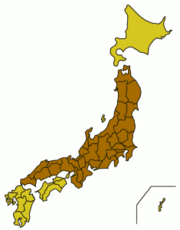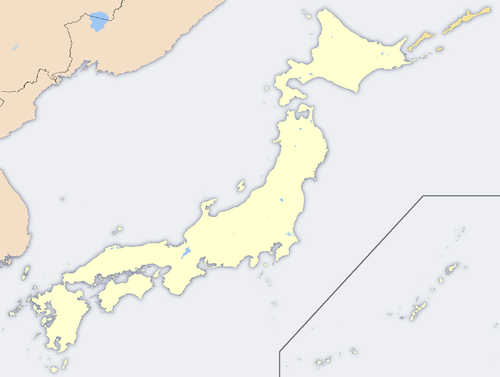Honshū
| Native name: 本州 | |
|---|---|
 Honshū |
|
 Honshū (Japan)
|
|
| Geography | |
| Location | East Asia |
| Archipelago | Japanese Archipelago |
| Area | 227,962.59 km² |
| Area rank | 7th |
| Coastline | 5,450 km (3,390 mi) |
| Highest elevation | 3,776 metres (12,388 ft) |
| Highest point | Mount Fuji |
| Country | |
|
Japan
|
|
| Prefectures | Hiroshima, Okayama, Shimane, Tottori, Yamaguchi, Hyōgo, Kyoto, Mie, Nara, Osaka, Shiga, Wakayama, Chiba, Gunma, Ibaraki, Kanagawa, Saitama, Tochigi, Tokyo, Akita, Aomori, Fukushima, Iwate, Miyagi, Yamagata, Aichi |
| Largest city | Tokyo (pop. 12,570,000) |
| Demographics | |
| Population | 103,000,000 (as of 2005 Census) |
| Ethnic groups | Japanese |
Honshū (本州, literally "Main State") (also spelled Honshu) is the largest island of Japan. The nation's main island, it is south of Hokkaidō across the Tsugaru Strait, north of Shikoku across the Inland Sea, and northeast of Kyūshū across the Kanmon Strait. It is the seventh largest island in the world, and the second most populous after Java in Indonesia.
The island is roughly 1,300 kilometres (810 mi) long and ranges from 50 to 230 km wide, and its total area is 227,962.59 km², 60% of the total area of Japan. It is larger than the island of Great Britain, and slightly larger than the state of Minnesota. Its area has been expanding with land reclamation and coastal uplift in the north, but global sea level rise have diminished these effects. Honshū has 5,450 kilometres (3,390 mi) of coastline.
Mountainous and volcanic, Honshū has frequent earthquakes (the Great Kantō earthquake heavily damaged Tokyo in September 1923); the highest peak is the active volcano Mount Fuji at 3,776 m, which makes it the world's 7th highest island. There are many rivers, including the Shinano River, Japan's longest. The climate is temperate, but has marked difference between the eastern or southern (Pacific or Inland Sea coast) side, and the western or northern (Sea of Japan coast) side. A mountain range runs along the length of Honshū from end to end. In addition to Mt. Fuji, the Japanese Alps are features of Honshū.
It has a population of 103 million in 2005, (98,352,000 as of 1990; in 1975 it was 89,101,702), mostly concentrated in the available lowlands, notably in the Kantō plain where 25% of the total population reside in the Greater Tokyo Area, which includes Tokyo and Yokohama, Kawasaki, Saitama and Chiba cities. Most of the nation's industry is located along the belt running from Tokyo along Honshū's southern coastal cities, including Kyoto, Osaka, Nagoya, Kobe, and Hiroshima, part of the Taiheiyo Belt.
The economy along the northwestern coast by the Sea of Japan is largely fishing and agriculture;[1] Niigata is noted as an important producer of rice. The Kantō and Nōbi plains produce rice and vegetables. Yamanashi is a major fruit-growing area, and Aomori is famous for its apples.
Eminent historical centers include Kyoto, Nara, and Kamakura.
The island is nominally divided into five regions and contains 34 prefectures, including metropolitan Tokyo. The regions are Chūgoku (western), Kansai (southern, east of Chūgoku), Chūbu (central), Kantō (eastern), and Tōhoku (northern). Some smaller islands are included within these prefectures, most prominently Ogasawara Islands, Sado Island, Izu Oshima and Awaji Island.
The prefectures are:
- Chūgoku region — Hiroshima-ken, Okayama-ken, Shimane-ken, Tottori-ken, Yamaguchi-ken.
- Kansai — Hyōgo-ken, Kyoto-fu, Mie-ken, Nara-ken, Osaka-fu, Shiga-ken, Wakayama-ken.
- Chūbu — Aichi-ken, Fukui-ken, Gifu-ken, Ishikawa-ken, Nagano-ken, Niigata-ken, Toyama-ken, Shizuoka-ken, Yamanashi-ken.
- Kantō — Chiba-ken, Gunma-ken, Ibaraki-ken, Kanagawa-ken, Saitama-ken, Tochigi-ken, Tokyo-to.
- Tōhoku — Akita-ken, Aomori-ken, Fukushima-ken, Iwate-ken, Miyagi-ken, Yamagata-ken.
Honshū is connected to the islands of Hokkaidō, Kyūshū and Shikoku by tunnels or bridges. Three new bridge systems have been built across the islands of the Inland Sea between Honshū and Shikoku (Akashi Kaikyō Bridge and the Ohnaruto Bridge; Shin-Onomichi Bridge, Innoshima Bridge, Ikuchi Bridge, Tatara Bridge, Ohmishima Bridge, Hakata-Ohshima Bridges, and the Kurushima-Kaikyo Bridge; Shimotsui-Seto Bridge, Hitsuishijima Bridge, Iwakurojima Bridge, Yoshima Bridge, Kita Bisan-Seto Bridge, and the Minami Bisan-Seto Bridge), and the Seikan Tunnel connects Honshū with Hokkaidō.
Extreme points
The northernmost point on Honshū is the tip of the Shimokita Peninsula in Ōma, Aomori. At the southern extreme lies Cape Kure in Kushimoto, Wakayama. The island is bounded on the east by Todogasaki in Miyako, Iwate and on the west by Bishanohana in Shimonoseki, Yamaguchi. It spans more than eight degrees of latitude and 11 degrees of longitude.
References
- ↑ Kodansha Encyclopedia of Japan
|
|||||||||||||||||||||||||||||||||
